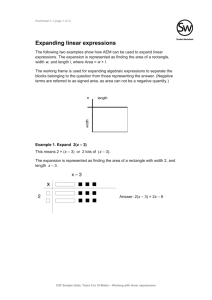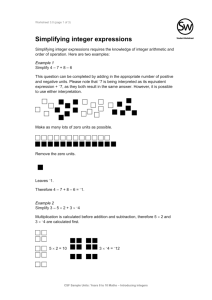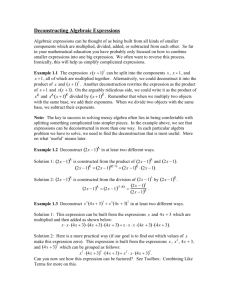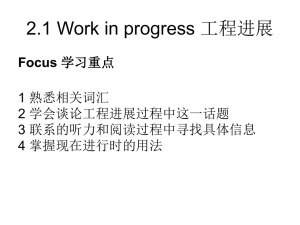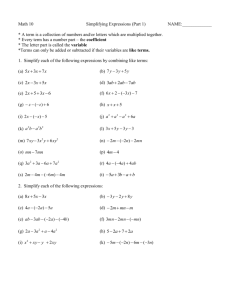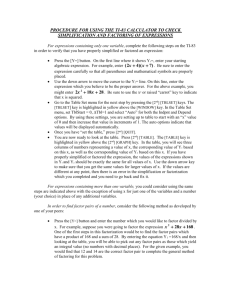Factorising linear expressions
advertisement
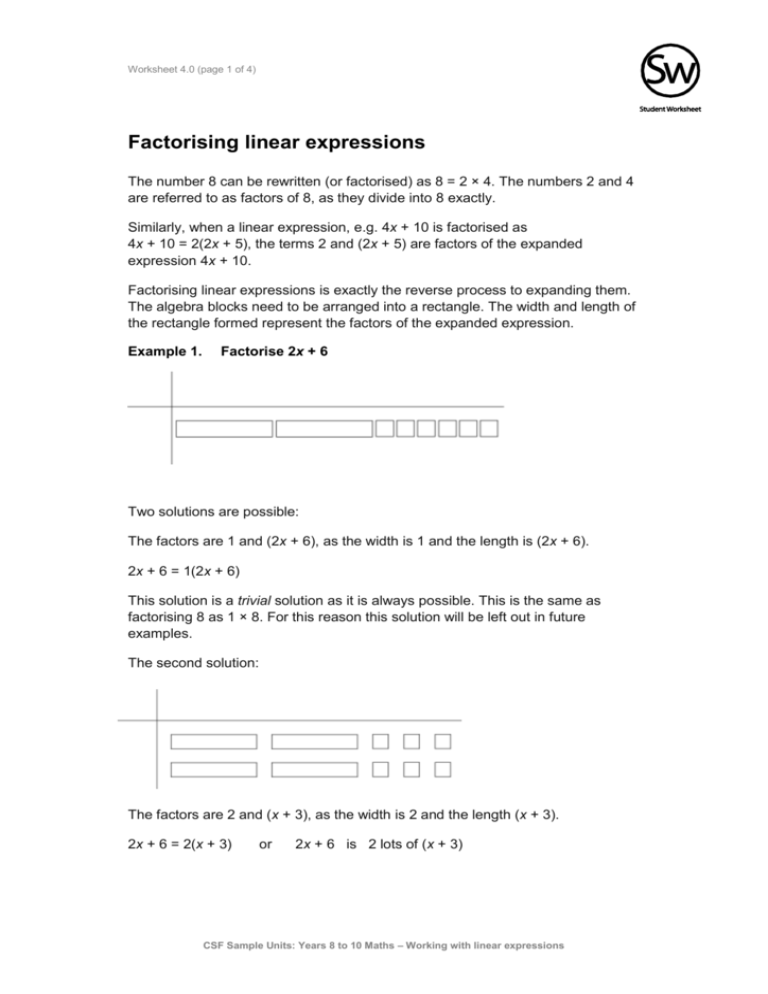
Worksheet 4.0 (page 1 of 4) Factorising linear expressions The number 8 can be rewritten (or factorised) as 8 = 2 × 4. The numbers 2 and 4 are referred to as factors of 8, as they divide into 8 exactly. Similarly, when a linear expression, e.g. 4x + 10 is factorised as 4x + 10 = 2(2x + 5), the terms 2 and (2x + 5) are factors of the expanded expression 4x + 10. Factorising linear expressions is exactly the reverse process to expanding them. The algebra blocks need to be arranged into a rectangle. The width and length of the rectangle formed represent the factors of the expanded expression. Example 1. Factorise 2x + 6 Two solutions are possible: The factors are 1 and (2x + 6), as the width is 1 and the length is (2x + 6). 2x + 6 = 1(2x + 6) This solution is a trivial solution as it is always possible. This is the same as factorising 8 as 1 × 8. For this reason this solution will be left out in future examples. The second solution: The factors are 2 and (x + 3), as the width is 2 and the length (x + 3). 2x + 6 = 2(x + 3) or 2x + 6 is 2 lots of (x + 3) CSF Sample Units: Years 8 to 10 Maths – Working with linear expressions Worksheet 4.0 (page 2 of 4) Factorise 4x – 6 Example 2. First attempt: This diagram does not have the pieces arranged as a rectangle, therefore this is not a solution. This is the diagram of 4x – 6 = 4(x – 1) – 2 Trying a different arrangement, The factors are 2 and (2x – 3). Therefore, 4x – 6 = 2(2x – 3) 1. Use algebra blocks to factorise the following expressions. a) 2x + 8 f) 5x – 10 b) 4x + 12 g) 4x – 4 c) 3x + 9 h) 4x – 10 d) 2x – 10 i) 6x + 9 e) 3x – 12 j) 4x – 14 CSF Sample Units: Years 8 to 10 Maths – Working with linear expressions Worksheet 4.0 (page 3 of 4) 2. Use algebra blocks to factorise the following expressions. a) –2x – 4 f) –4x + 6 b) –4x – 12 g) –2x – 10 c) –3x – 6 h) –3x – 15 d) –3x + 6 i) –4x + 10 e) –5x + 15 j) –4x + 16 Example 3. The following expressions are all equal. They are referred to as equivalent expressions. Not all equivalent expressions below represent factors of 4x – 6. 2(x – 3) is the only equivalent expression which represents factors of 4x – 6, the other expressions do not form complete rectangles. 4x – 6 = 2(2x – 3) = 4(x – 1) – 2 = 4(x – 2) + 2 CSF Sample Units: Years 8 to 10 Maths – Working with linear expressions Worksheet 4.0 (page 4 of 4) 3. Use your algebra blocks to find three equivalent expressions for each of the expressions listed below. At least one of these equivalent expressions must be a factor of the initial expression. Write the equivalent expressions algebraically and circle those expressions which also represent factors. a) 6x + 12 b) 4x – 4 c) 3x – 6 d) 9x – 6 e) –4x + CSF Sample Units: Years 8 to 10 Maths – Working with linear expressions CSF Sample Units: Years 8 to 10 Maths – Working with linear expressions
